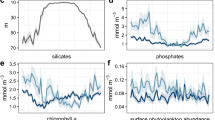Abstract
The paper presents an analysis and discussion on a phenomenon of Lake Baikal spring phytoplankton known as ‘melosira years,’ or high-productive years, which are years when spring a psychric set of planktonic algae intensively blooms in the interstitial water within the thawing ice and in the under-ice water. Alternative of these high- and low-productive years is one of greatest baikalian mysteries long attracting researchers’ attention. Analysis of a sequence of high-productive years from 1943 to present, allowed us to reveal 11- and 10-year cycles in long-term dynamics of the Lake Baikal spring phytoplankton. Within these basic cycles we have found enclosed three intervals between high-productive years. Moreover, these intervals being usually 3 and 4 years long became doubled, i.e., 6 and 8 years long, from 1968 to 1990 that equals 22 years in length, or two 11-year fragments. This phenomenon of doubling can be explained in terms of the resonance theory so we consider the ‘melosira years’ phenomenon to be bound up with solar activity, resonantly influencing baikalian phytoplankton. Also we found that Lake Baikal spring phytoplankton skip between their 11- and 10-year cycles in conforming to a current solar activity length.
Similar content being viewed by others
References
Amsheev R. M. (1992). Ecological bases of out-bursts in reproduction of insects in Zabaikalie. Russian Journal of Ecology 3: 80–83, (In Russian)
Amsheev R. M., Boldaruev V. O. (1987). Monitoring and Forecasting Number of Forest Pests. Buryatian Dept Siberian Branch USSR Acad. Scs publishers, Ulan-Ude, (In Russian)
Antipova N. L. (1963a). Number variations of the Melosira species in Lake Baikal plankton. Proceedings of the USSR Hydro-biology Society 13: 235–241, (In Russian)
Antipova N. L. (1963b). Seasonal and annual changes of phytoplankton in Lake Baikal. Proceedings of the Limnological Institute, Siberian Branch of USSR Academy of Sciences 2(22): 12–28, (in Russian)
Antipova N. L., Kozhov M. M. (1953). Materials on seasonal and annual variations of phytoplankton forms dominant in Lake Baikal. Proceedings of the Irkutsk State University 7: 63–68, (In Russian)
Bondarenko, N. A., 1997. Structure and production characteristics of Lake Baikal phytoplankton. Ph.D. Thesis, Biological Sciences, Borok. (In Russian)
Bondarenko, N. A. & V. K. Evstafyev, 2000. Long-term dynamics of the baikalian phytoplankton tuned up by the solar rhythms. Abstracts of 43rd Annual Conference on Great Lakes and St. Lawrence River Research, Cornwall, Canada, May 22–26th, 2000: 1–15
Elton C. S., Nicholson A. J. (1942). The ten-year cycle in number of the lynx in Canada. Journal of Animal Ecology 11: 215–244
Evstafyev, V. K. & N. A. Bondarenko, 2000. Standing waves model of the long-term phytoplankton dynamics in Lake Baikal. Biophysics 6: 1056–1062. (English version of the Russian paper: The “standing waves” model of baikalian phytoplankton inter-annual dynamics. Biofizika 6: 1089–1095)
Evstafyev V. K., Bondarenko N. A. (2002). Nature of the “melosira years” phenomenon in Lake Baikal. Hydrobiology Journal (Ukrainian) 1: 3–12, (in Russian)
Graph and Table of Monthly Mean Sunspot Numbers 1950-present. Solar-Geophysical Data prompt Biological Society 11: 28–43 (in Russian)
Kozhova O. M., Beym A. M. (1993). Ecological Monitoring of Lake Baikal. “Ecologia” Publ., Moscow, p. 59, (in Russian)
Makarova I. V., Pichkily L. O. (1970). To some aspects of how to measure phytoplankton biomass. Botanical Journal 10: 1488–1494, (in Russian)
Moran P. A. P. (1953). The statistical analysis of the Canadian lynx cycle. Australian Journal of Zoology 1: 163–173
Nakanishi, M., 1984. Phytoplankton. In Horie, S. (ed.), Lake Biwa. Dr. W. Junk Publishers, 281–290
Obolkina L. A., Bondarenko N. A. et al. (2000). On a finding of a cryophilic community in Lake Baikal. Reports of Russian Academy of Sciences 371: 815-817, (in Russian)
Popovskaya G. I. (1987). Phytoplankton of the world’s deepest lake. Proceedings of the Zoological Institute of USSR Academy of Sciences 172: 107–116, (in Russian)
Shimaraev M. N. (1971). Hydro-meteorological factors and variations in abundance of Lake Baikal plankton. Proceedings of the Limnological Institute of Siberian Branch USSR Academy of Sciences 12: 259–267, (in Russian)
Internet site of “Sunspot Index Data Center”: http://sidc.oma.be/DATA/yearssn.dat
Verkhozina V. A., Kozhova O. M., Kusner Y. S. (2000). Hydrodynamics as a limiting factor in the Lake Baikal ecosystem. Aquatic Ecosystem Health and Management 3: 203–210
Vitinsky Y. T. (1973). Cycles and Forecasting Solar Activity. “Nauka” Publishers, Leningrad 241–249, (in Russian)
Votintsev K. K. (1961). Hydrochemistry of Lake Baikal. USSR Acad. Scs Publ., Moscow, 246–248, (in Russian)
Votintsev, K. K., A. I. Meshcheryakova & G. I. Popovskaya, 1975. Organic Matter Circulation in Lake Baikal. “Nauka” Publ., Novosibirsk, (in Russian) p. 98
Author information
Authors and Affiliations
Corresponding author
Rights and permissions
About this article
Cite this article
Bondarenko, N.A., Evstafyev, V.K. Eleven- and ten-year basic cycles of Lake Baikal spring phytoplankton conformed to solar activity cycles. Hydrobiologia 568 (Suppl 1), 19–24 (2006). https://doi.org/10.1007/s10750-006-0339-1
Issue Date:
DOI: https://doi.org/10.1007/s10750-006-0339-1




